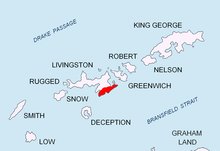Nestinari Nunataks



Nestinari Nunataks (Nestinarski Nunatatsi \ne-sti-'nar-ski 'nu-na-ta-tsi\) are a pair of rocky peaks of elevation 470 m and 520 m in middle Huron Glacier, Livingston Island in the South Shetland Islands, Antarctica. Situated in the north foothills of Tangra Mountains, 210 m away from each other.
They are named after the Greco-Bulgarian folkloric ritual of ‘Nestinari’ involving barefoot dancing on live embers.[1]
Location
The higher nunatak is located at 62°38′43.5″S 60°05′19.5″W / 62.645417°S 60.088750°W, which is 2.55 km east of Lozen Nunatak, 3.88 km east-southeast of Kuzman Knoll, 1.1 km northwest of Plana Peak, 2.6 km north-northeast of Levski Peak and 1.49 km east-northeast of Ravda Peak (Bulgarian topographic survey Tangra 2004/05, and mapping in 2005 and 2009).
Maps
- L.L. Ivanov et al. Antarctica: Livingston Island and Greenwich Island, South Shetland Islands. Scale 1:100000 topographic map. Sofia: Antarctic Place-names Commission of Bulgaria, 2005.
- L.L. Ivanov. Antarctica: Livingston Island and Greenwich, Robert, Snow and Smith Islands. Scale 1:120000 topographic map. Troyan: Manfred Wörner Foundation, 2009. ISBN 978-954-92032-6-4
- Antarctic Digital Database (ADD). Scale 1:250000 topographic map of Antarctica. Scientific Committee on Antarctic Research (SCAR). Since 1993, regularly upgraded and updated.
- L.L. Ivanov. Antarctica: Livingston Island and Smith Island. Scale 1:100000 topographic map. Manfred Wörner Foundation, 2017. ISBN 978-619-90008-3-0
- A. Kamburov and L. Ivanov. Bowles Ridge and Central Tangra Mountains: Livingston Island, Antarctica. Scale 1:25000 map. Sofia: Manfred Wörner Foundation, 2023. ISBN 978-619-90008-6-1
References
- ^ "Nestinari Nunataks". Scientific Committee on Antarctic Research (SCAR). Retrieved 29 September 2019.
- Nestinari Nuntaks. SCAR Composite Gazetteer of Antarctica
- Bulgarian Antarctic Gazetteer. Antarctic Place-names Commission. (details in Bulgarian, basic data in English)
External links
- Nestinari Nunatak. Copernix satellite image
This article includes information from the Antarctic Place-names Commission of Bulgaria which is used with permission.
